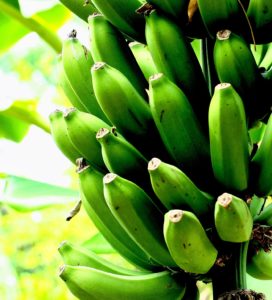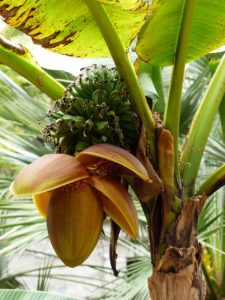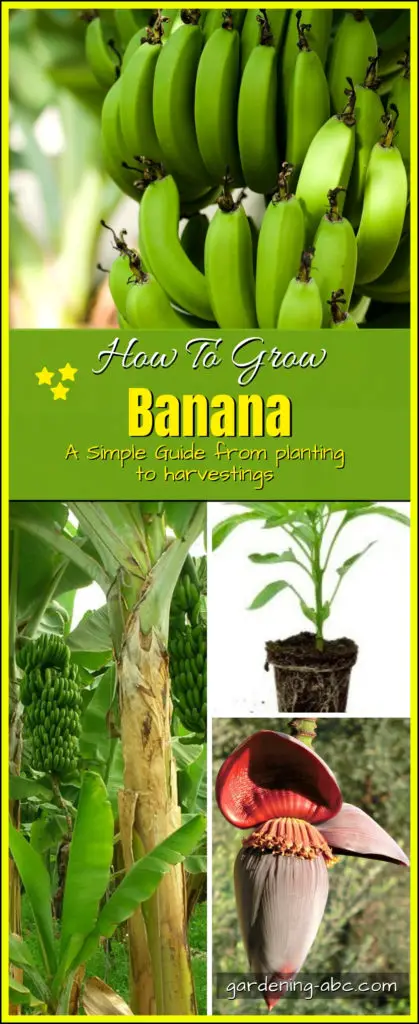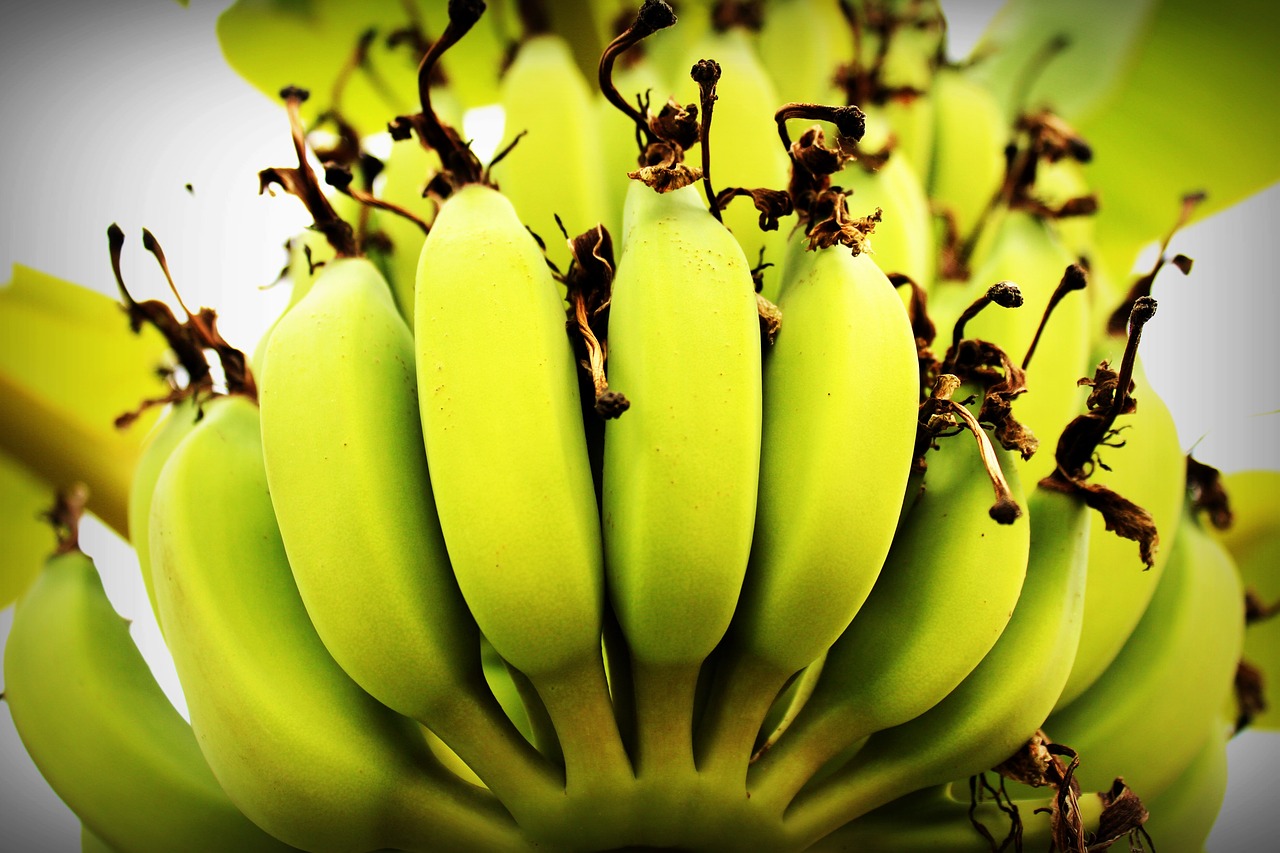We use affiliate links to run our site. When you buy through links on our site, we may earn an affiliate commission, without any added cost to you. Learn more
Growing bananas is not very tough. Anybody can use their backyard to grow them. Here, in this post, we will discuss how to grow bananas and give you some essential tips that will be helpful in growing bananas.
Banana is a tropical plant. It needs a tropical or warm subtropical climate to thrive. They can handle a bit of cold or very hot climate but the ideal temperature for banana growing is around 26-30°C (78-86°F).
Bananas are closely related to ginger plants, they belong to the same order Zingiberales. The trunk of a banana tree is different than any other tree. Unlike other trees in bananas, all the leaf stalks get wrapped around each other and form the trunk.
Below the ground new leaves, flowers, etc start forming inside. Then, they push up through the middle and emerge from the center of the crown.
Banana Varieties:

There are a number of varieties of bananas. You can use them for cooking, as fresh, and also ornamentals. If your sole purpose is growing as ornamental you can choose any variety as long as their look and size fit your requirement. Here are some popular banana varieties:
Blue Java or Musa acuminata:
The blue java variety is very popular in Hawaii, Central America, and Southeast Asia. The plant reaches around 12 to 20 feet tall and produces blue to green color fruits.
They have paddle-shaped leaves that can reach around 6 to 10 inches long. You can use them for ornamental purposes.
Flowering Banana or Musa ornata:
They are mainly grown for ornamental uses. They have small fruits that are not edible.
Japanese Banana or Musa basjoo:
This variety can reach a height of around 6 to 14 feet and can tolerate cold quite well.
The best way to propagate banana trees is from suckers and not from seeds. Unlike wild bananas, normal banana trees do not produce viable seeds from growing plants.
The rhizome of the banana plant has many growing points from where suckers form. It remains at the base of a banana plant, under the ground.
A banana plant releases many suckers from its base. Using a sharp shovel cut the suckers from the main plant. Keep in mind, you need a good chunk of corm and many roots with the sucker.
Select suckers from a healthy growing plant. It should be more than a couple of feet in height and have some leaves with it. You can also grow bananas from smaller suckers but it will take a longer time.
It is better to remove them in the early stages. Once the main plant becomes taller (close to 2 meters) you can let the suckers grow into other banana plants.
Plant your suckers in your well-prepared banana patch. Keep a gap of 2-5 meters between two banana plants. Keep your banana plants moist but not too wet in the early days or they may rot. Generally, they won’t need much water initially as the evaporation through leaves will be very low.
In most cases, we use tissue-cultured banana transplants for planting. This is not a plant that you consider growing from the seeds.
Planting Location:
Like most fruit-bearing plants, the Banana also requires a good amount of water and full sunlight. So plant bananas in a place where 8 hours of sunlight is available.
Ideal Soil For Growing Bananas:
One of the most important parts of growing quality bananas is to prepare the soil with lots of nutrients and good drainage.
If you don’t have very fertile soil in your garden you can easily make the soil fertile. Add lots of compost and manure to your soil before planting bananas. You can also add a bit of wood ash for extra potassium.
The best way to make sure that your soil will retain water and will not get waterlogged is to add Coconut coir or Perlite to the soil.
Soil pH:
Banana trees love slightly acidic soil. The ideal pH for growing good-quality bananas is 6.5.
Planting:
Plant them 30–60 cm (11.8–23.6 in) deep in the soil before the monsoon. Depending on the variety of the banana plant adjust the spacing between two banana plants. While planting bananas, makes sure that the roots of the plant get covered with the soil with at least ½ inch depth.
Banana plants need room to grow properly. so do not plant too many banana plants together. They also need shelter from strong winds, keep this in mind while planting.
Weeding:
After planting the bananas, you have to weed the soil for at least 6 weeks. At this time banana plants are not very tall to compete against other competing weeds. We have a detailed article on how to weed your garden, see that for more information
How to Fertilize Banana Plants:
Fertilizing banana plants is an important process that helps to ensure the plant’s health and productivity. By providing the plant with essential nutrients, fertilizer helps to encourage strong growth and fruit production.
While there are many different ways to fertilize banana plants, some of the most common methods include using compost or manure.
Banana plants are very voracious eaters, so you need to add nutrients continuously to the soil. Add compost from time to time. It will help the plant to grow vigorously.
Use a thick layer of mulch to cover the base. This will suppress the weeds nearby.

There are mainly 3 things you need to take care of while maintaining a banana patch:
- Make sure your bananas are getting enough water. The huge soft leaves evaporate a lot so you have to water the soil frequently. If you are growing bananas commercially, you may have to sprinkle water into your patch 2-3 times a day to keep the humidity level up.
- Banana plants eat a lot. So keep adding compost, manure, fertilizers, etc regularly so that the plants don’t get starved.
- Protect your plants from strong winds. Leaf tattering by wind is one of the most common problems in growing bananas.
Pruning:
A little bit of trimming is essential for banana plants. Before the banana tree fruits, prune it so there is only one main stem. Cut down all other offshoots as they appear.
Remove all the leaves that are diseased or became yellow. It will help the water and other nutrients to reach the healthy parts of the plant resulting in good quality yield.
Use a sharp knife to remove all the extra shoots and leaves. Remember, you should always cut them up and not down.
When to Harvest Bananas:
A banana plant takes about 9 months to grow up and produce a bunch of bananas. Bananas taste best when they have ripened in the plant. Remove them once they become yellow. If your banana tree is not producing bananas these may be the reasons.
You can remove the whole bunch in a single time. In this case, they will ripen inside your house. But be careful, a whole bunch of bananas can weigh close to 45 kilos. Take somebody’s help in removing them from the plant.
After the harvest, cut the main stem down to 2.5 feet. Remove the rest of the stem in a few weeks, and leave the replacement sucker intact.
Nutrition Value of Bananas:
Banana is a source of nutrition. It is filled with vitamins A, B6, and C, minerals such as Potassium, and lots of fiber.
Conclusion:
Growing bananas in your backyard can be a rewarding experience if you follow the tips mentioned in this post. Banana plants require proper climate, soil, and sunlight conditions. You should also select healthy suckers, plant them in well-prepared soil, and fertilize the banana plants continuously.
By following these tips, you can enjoy fresh bananas from your backyard and enhance your gardening skills.
So why not give it a try? And while you’re at it, don’t forget to explore our other articles on gardening and home improvement. Share this post with your friends and family, and let’s all get growing!
Like this post? Don’t forget to PIN IT

Amazon and the Amazon logo are trademarks of Amazon.com, Inc, or its affiliates.
